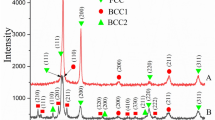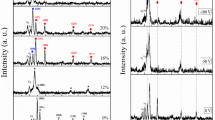Abstract
The mechanical and tribological characteristics of titanium–aluminum nitride films deposited by the reactive magnetron sputtering of Ti–Al mosaic targets with different aluminum concentrations were studied. The dependences of the elemental composition, microhardness, and friction coefficient on the degree of doping of the films with aluminum and nitrogen concentration in the Ar/N2 gas mixture during film deposition were obtained. It was found that an increase in the aluminum content in the film results in an increase in film hardness and decrease in the friction coefficient. The optimum nitrogen concentration in the film was achieved at maximum hardness and low values of the friction coefficient. A maximum hardness of 23.5 GPa and a minimum friction coefficient of 0.082 were obtained for films of the composition Ti5AlN1.33, which had a Ti/Al ratio of 5 : 1 and a nitrogen deficiency.






Similar content being viewed by others
REFERENCES
Inspektor, A. and Salvador, P.A., Architecture of PVD coatings for metalcutting applications: a review, Surf. Coat. Technol., 2014, vol. 257, pp. 138–153.
Chim, Y.C., Ding, X.Z., Zeng, X.T., and Zhang, S., Oxidation resistance of TiN, CrN, TiAlN and CrAlN coatings deposited by lateral rotating cathode arc, Thin Solid Films, 2009, vol. 517, pp. 4845–4849.
Musil, J. and Vlček, J., Magnetron sputtering of alloy and alloy-based films, Thin Solid Films, 1999, vols. 343–344, pp. 47–50.
Kawate, M., Hashimoto, A.K., and Suzuki, T., Oxidation resistance of Cr1 – xAlxN and Ti1 – xAlxN films, Surf. Coat. Technol., 2003, vol. 165, no. 2, pp. 163–167.
PalDey, S. and Deevi, S.C., Single layer and multilayer wear resistant coatings of (Ti,Al)N: a review, Mater. Sci. Eng., A, 2003, vol. 342, pp. 58–79.
Zhirkov, I., Petruhins, A., and Rosen, J., Effect of cathode composition and nitrogen pressure on macroparticle generation and type of arc discharge in a DC arc source with Ti–Al compound cathodes, Surf. Coat. Technol., 2015, vol. 281, pp. 20–26.
Chang, H.-W., Huang, P.-K., Davison, A., Yeh, J.-W., Tsau, C.-H., and Yang, C.-C., Nitride films deposited from an equimolar Al–Cr–Mo–Si–Ti alloy target by reactive direct current magnetron sputtering, Thin Solid Films, 2008, vol. 516, pp. 6402–6408.
Kong, Y., Tian, X., Gong, C., Tian, Q., Yang, D., Wu, M., Li, M., and Golosov, D.A., Microstructure and mechanical properties of Ti–Al–Cr–N films: effect of current of additional anode, Appl. Surf. Sci., 2019, vol. 483, pp. 1058–1068.
Nakano, J., Miyazaki, H., Kimura, T., Goto, T., and Zhang, S., Thermal conductivity of yttria-stabilized zirconia thin films prepared by magnetron sputtering, J. Ceram. Soc. Jpn., 2004, vol. 112, pp. S908–S911.
Grigor’ev, A.Ya., Devices and research methods of contact interaction of solids, Vestsi Nats. Akad. Navuk Belarusi, Ser. Fiz.-Tekh. Navuk, 2018, vol. 63, no. 1, pp. 53–67.
Ermolenko, M.V., Zavadski, S.M., Golosov, D.A., Melnikov, S.N., and Zamburg, E.G., Tribological behavior of TiN films depositid by reactive magnetron sputtering under low pressure, J. Frict. Wear, 2016, vol. 37, no. 3, pp. 289–292.
Svadkovski, I.V., Zhu Chang, Golosov, D.A., and Zavatskiy, S.M., Mechanical and Tribological Properties of AlN Thin Films, J. Xi’an Inst. Technol., 2006, vol. 26, no. 3, pp. 237–240.
Funding
The work was supported by the Belarusian Republican Foundation for Fundamental Research, project no. T18P-092 and the Russian Foundation for Basic Research, project no. 18-58-00004 Bel_a.
Author information
Authors and Affiliations
Corresponding author
About this article
Cite this article
Golosov, D.A., Oks, E.M., Burdovitsin, V.A. et al. Effect of the Degree of Aluminum Doping on the Mechanical and Tribological Characteristics of Titanium–Aluminum Nitride Films. J. Frict. Wear 41, 304–309 (2020). https://doi.org/10.3103/S1068366620040066
Received:
Revised:
Accepted:
Published:
Issue Date:
DOI: https://doi.org/10.3103/S1068366620040066




